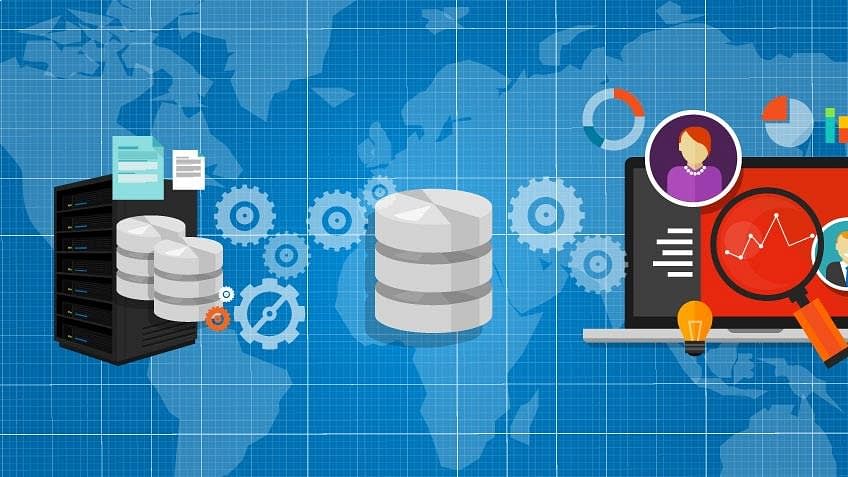As ‘Enterprise’ might include a government agency, a corporation, or just a division of it, a single department in an organization, or as much as a chain of organizations linked together by common ownership. In the extended form, it will also include the partners, suppliers, and customers, as well. Enterprise Architecture, then, is the tool that optimizes the manual and automated processes initiated to achieve a competitive edge into an integrated environment.
Effective Enterprise Architecture helps tap useful information for business progress, through IT and also helps build the balance in the use of IT in business innovation. TOGAF® helps achieve this by building the right tool (Enterprise Architecture) by aligning business needs with IT architecture of the various choices available, one exemplary framework that sits head and shoulders above the competition is The Open Group’s Architecture Framework or TOGAF®.

In this piece, we shall explore the pros of cons of implementing TOGAF® to meet your Enterprise Architecture needs, and chart out its benefits to both, the organization, and you, as an individual employee.
What is TOGAF®?
The Open Group, a technology-neutral industry association with over 450 member organizations, develops and builds The Open Group Architecture Framework (TOGAF®) − a documented framework which enables users and organizations to leverage the complex tool of Enterprise Architecture to design, evaluate and build the right architecture for the business. And although TOGAF® is designed to primarily support Information Technology (IT) architecture, it also includes “parts of the business, data and application architecture that impact the development of IT architecture”.
Since its inception in the 1990s, the applicability of TOGAF® has undergone incremental value-addition with the constant evolution of the enterprise and the IT architecture vertical. The features of TOGAF® have also improved over the years, with the latest version, TOGAF® 9.1, at the apex of the pyramid.
Enterprise Architecture lays out a path from the present to the progressive future of an organization by helping align the business framework of the organization with the necessary data needed to manage and execute the business. This includes the technology needed to process the collected data. It is at this juncture that TOGAF® finds its greatest utility.
What Are The Benefits Of Implementing TOGAF®?
To Organizations
- Ease Of Implementation The foremost benefit of using TOGAF® for an organization’s EA is that the Open Group’s framework offers an easy-to-understand, step-by-step approach to developing Enterprise Architecture and is therefore easy to use, helping organizations and employees save on excessive training costs.
- Ease Of Use: In keeping with point #1, once implemented, TOGAF® is also simple to use and comes with exhaustive documentation, meaning organizations and IT admins will have little to no trouble keeping the IT architecture in top shape. Further, TOGAF® is among the few IT frameworks that can be implemented and maintained by architects of any skill or experience level.
- Global Standard: As THE standard in Enterprise Architecture and the most-popular framework in the world, TOGAF® provides a standardized architecture development process and common definitions of components and deliverables. This means TOGAF® is easier to transfer and apply between industries and across business units\geographies.
- Authentic: TOGAF® framework is a compilation of the efforts from all of TOG’s (The Open Group’s) member organizations and hence offers a well-founded corroborative theoretical framework that supports the complex process of developing and sustaining an Enterprise Architecture.
- Procedural: TOGAF®’s ADM (Architecture Development Method; see fig. 1) or the “framework of frameworks”, provides the most comprehensive process for architecture development that isn’t overly complex, yet.
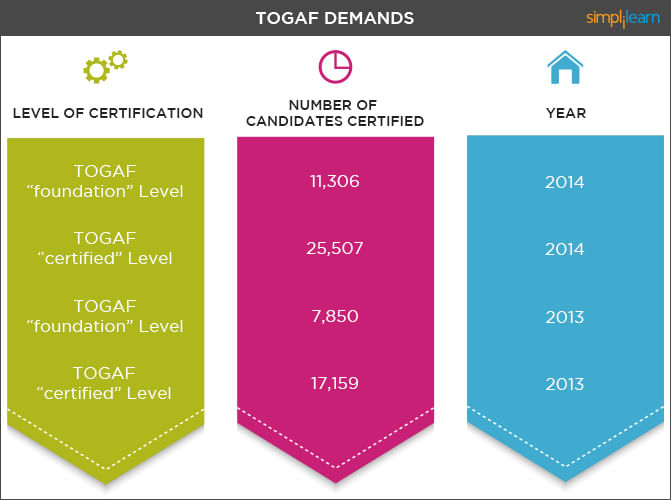
- Flexible: TOGAF® is not merely monolithic as it can be used in conjunction and integrated with other frameworks. That is to say, it can either be used completely or partially based on enterprise requirements. It can be used in both large scale and small scale businesses and is user-friendly for all schemes of work. All the needs are met in an organized manner that ensures satisfactory products.
TOGAF® to MODAF mapping: https://www.bmt-hqs.com/media/3991716/TOGAF®_to_modaf_mapping.pdf
- Versatility: Because of the size and scope of any enterprise-level architecture deployment, large organizations quite often benefit from a more comprehensive implementation of a framework, while smaller and less complex enterprises use only those parts of the framework that add value at their scale. TOGAF®’s design and structure make it an inherently-versatile tool that makes this possible.
- Uses Tested Ideas – Open Systems Framework: TOGAF® uses viable ideas that have been tried and proven functional, meaning consumer satisfaction is almost a given.
- Intelligent Procurement Specification: TOGAF®’s open systems implementation facilitates an excellently-designed procurement specification. This means that consumers will have their expectations met because it has been tried before and continuously improved to meet the highest quality of needs.
- Popularity: TOGAF® is the most popular and widely implemented framework across the world, and is utilized by businesses operating in a broad range of sectors, including healthcare, academia, aerospace, media, mining, retail, telecom, and dozens more!
- No Dearth Of Training: Owing to the popularity of the framework in itself and the huge success quotient in its implementation, there are a large number of professionals who have equipped themselves with certification and, in turn, act as certified TOGAF® practitioners and trainers to aspiring candidates. Companies looking to implement TOGAF® will, as a result, be able to find local trainers with consummate ease, further saving training costs. For a list of companies that currently implement TOGAF®, visit the Open Group’s Users’ page.
- Freely Available Public Domain Material: All the content and documentation pertaining to TOGAF® are available free of cost on the Open Group website, thus easing accessibility to the framework. Joining the Open Group is not mandatory to be able to use TOGAF®. The only cost that may have to be incurred is the payment for specific publications.
- Frees Up Licensing Costs For Other Frameworks: Utilizing TOGAF® as your central IT architecture framework frees up resources that may be expended into acquiring an additional, secondary framework to complement TOGAF®’s core functionalities.
- Up-To-Date Body Of Knowledge: The Open Group strives to keep the TOGAF® BoK (Body of Knowledge) up-to-date to keep pace with the latest developments, ideas, and thought in the field of EA (TOGAF® 9.1 is the most recent version).
- Open Systems Implementation: Since TOGAF® is a global, open standard, using TOGAF® confers all the benefits of an Open Systems implementation –without the risks!
- TOGAF® For Organizational Improvement: TOGAF® also ‘aligns and integrates’ with organizational improvement processes, such as the Baldrige Criteria, and organizational change models such as Kotter’s 8-step process. Businesses implementing TOGAF® can thus invest in organizational improvement programs without having to provide buffers to protect the IT architecture from damage.
- Structural Advantages: The structure of the TOGAF® framework lends itself fairly well to versatile application across functions: the various components of TOGAF® are beneficial in their own right.

- Components of TOGAF® (the repositories, metamodels, etc.) help achieve the right knowledge management, program management, and other processes in an organization.
- TOGAF® Technical Reference Model (TRM) provides the taxonomy of generic platform services.
- The TOGAF® Standards Information Base (SIB), a database of open industry standards, can be used to define the particular services and components of an enterprise-specific architecture.
- The integrated Information Infrastructure Reference Model (III-RM), a model based on the TOGAF® Foundation Architecture is aimed at assisting the design of architectures that enable and support Boundaryless Information Flow.
- The BBIB (Building Block Information Base), like the SIB and TRM, is another pillar in the architecture framework that presents the taxonomy derived from common systems architectures available for a specific domain. (Figure. 2)
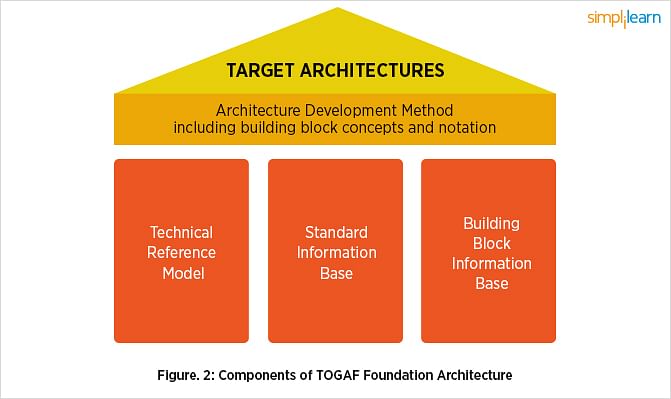
Functions of TOGAF® in the different types of architectures
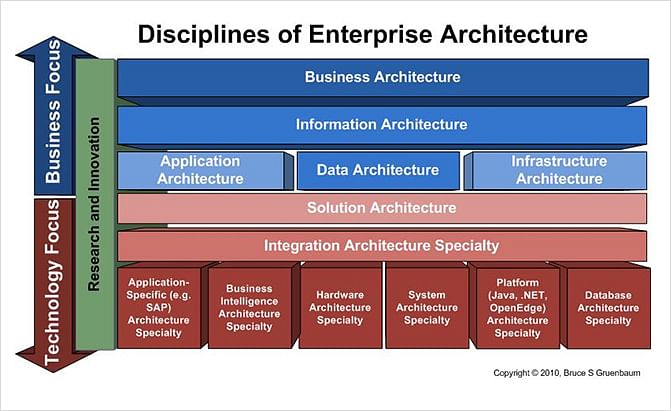
-
In Business Architecture:
Business Architecture defines the business strategy, governance, and key business processes. To justify an overview level, it may be said, TOGAF® helps define and align business architecture with the other components of the enterprise architecture.
-
In Application Architecture:
TOGAF® ensures that applications are created in a way that intercommunication between them is efficient. Data exchange between them is well taken care of in the underlying architecture. Essential services from the application will be achieved due to the TOGAF® 9.1 design that has systemic features in the whole IT environment.
-
In Data Architecture:
There is an impressive logical manner in the arrangement of data assets that are observed. TOGAF® makes it very easy to move huge chunks of data in a neat and organized way, without any loss of information.
-
In IT Architecture:
The necessary software and hardware required to develop various applications are well provided making IT work in an organized manner. Also, necessary support for the distribution of business, data, and application services is provided by TOGAF® as it helps build suitable and needed IT infrastructure, middleware, networks, communications, processing, etc.
Adding to all the advantages is the constant improvisation of the TOGAF® versions that the Open Group comes up with. The Open Group designs and manages TOGAF®. And with periodic reviews that it conducts, revises the existing framework. The recent version - TOGAF® 9.1 is dynamic; in the sense, it offers more templates, more guidelines to use and thereby has an increased rigor to it.
So What’s The Other Side Of The Coin?
Like any complex mechanism, TOGAF®-implementation does come with a few riders:
#1. It is difficult to learn and implement TOGAF® in a vacuum, and in isolation. It is suggested that professionals learn the basics of the framework along with its implementation in a training course. It should be ensured that these training courses should be conducted by an organization that is accredited by The Open Group.
#2. TOGAF® is a complicated framework and methodology that may require an entire team to manage its implementation. This team includes the manpower as well as the other forms of resources. The team will possibly be diverted from its primary function to perform this task.
#3. The methodologies advocated by the TOGAF® documentation do not directly help in easing the management of Enterprise Architecture but is limited to academically aid in organizing the architecture. It needs to be customized to suit the needs of organizations.
#4. The framework formalizes pre-design functions, thereby limiting the scope for experimentation and tweaking. The conventional method of figuring out what to produce at the end of an R&D process is not something TOGAF® allows.
Nevertheless, as our discussion has demonstrated, the advantages and benefits to learning and utilizing TOGAF® far outweigh its drawbacks, and getting a TOGAF® certification will stand any professional interested in reaching the highest echelons of IT in good stead!
Why Should I Get TOGAF® Certified?
For efficient utilization of the TOGAF® framework, knowing how to beneficially implement TOGAF® will prove profitable for organizations that wish to adopt this framework in its functioning, and TOGAF® certified architects will continue to remain in high demand.
1. A certmag.com survey ranks TOGAF® in the ninth position among the top 20 highest paying certifications in 2015. This is not surprising considering such organizations as IBM, HP, Oracle, Deloitte, Capgemini, CISCO and other leading giants are implementing TOGAF®® methodologies to transform their businesses, thereby increasing the job opportunities and the subsequent demands for TOGAF® certified architects.
2. Data from Indeed demonstrates why TOGAF® is such a sought-after domain for certification by IT professionals:
From these figures, it is clear that:
- TOGAF® professionals stand a great chance at breaking the $100,000\year barrier;
- Professionals with a TOGAF® certification are among the highest-paid professionals in the IT industry.
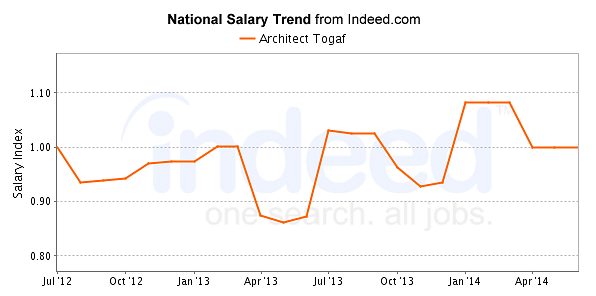
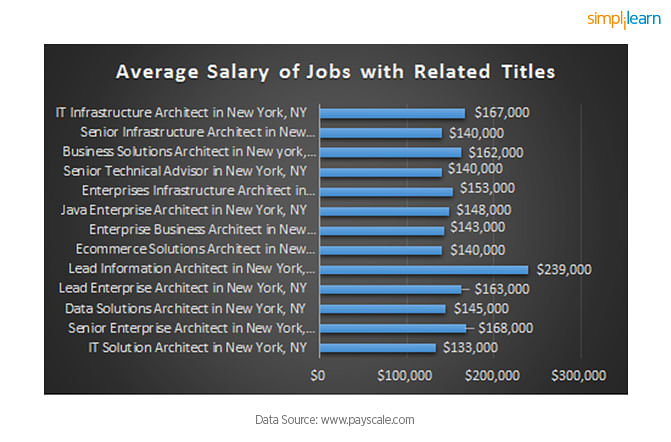
4. The spectrum of skills that professionals can build and develop through TOGAF® certification is also vast, and includes: business skills comprising of business cases, processes, strategic planning, Enterprise Architecture skills comprising of modeling, system integration, applications and role design, Project Management skills, certain legal knowledge into the data protection laws, contract law, procurement laws, etc., and also some of the generic skills such as leadership, team-building, and soft-skills.
